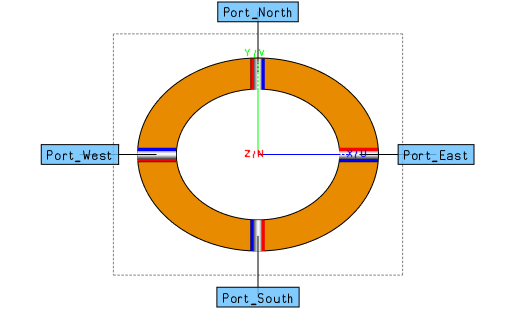Creating the Model
Create the model in CADFEKO. Define any ports and sources required for the model. Specify the operating frequency or frequency range for the model.
- Set the model unit to millimeters.
-
Define the following variables:
- rInU = 21 (The inner radius of the elliptic arc in the U direction.)
- rOutU = 31 (The outer radius of the elliptic arc in the U direction.)
- rInV = 0.8*rInU (The inner radius of the elliptic arc in the V direction.)
- rOutV = 0.8*rOutU (The outer radius of the elliptic arc in the V direction.)
- freq = 2.49e9 (The operating frequency.)
-
Create a quarter of the ring.
-
Create the first elliptic arc.
- Centre point: (0, 0, 0)
- Radius (Ru): rOutU
- Radius (Rv): rOutV
- Start angle (A0): 0°
- End angle (A1): 90°
-
Create the second elliptic arc.
- Centre point: (0, 0, 0)
- Radius (Ru): rInU
- Radius (Rv): rInV
- Start angle (A0): 0°
- End angle (A1): 90°
-
Create the first elliptic arc.
Create a quarter of the ring antenna.
-
Create a surface from the two elliptic arcs using the
Loft tool.
- Rename the label to sector_1.
-
Create the full ring antenna.
- Copy and mirror sector_1 around the UN plane.
- Copy and mirror sector_1 and the copied part from Step 5.a around the VN plane.
- Union the four sectors to create a single ring structure.
-
Create four edge ports.
- port_North with its port edge on the positive Y axis.
- port_East with its port edge on the positive X axis.
- port_South with its port edge on the negative Y axis.
- port_West with its port edge on the negative X axis.

Note: All four ports point in an anticlockwise direction. - Set the frequency to freq.
-
Specify the symmetry about 2 principal planes.
- X=0: Geometric symmetry.
- Y=0: Geometric symmetry.
Tip: Exploit model symmetries (if it exists) in a large or complex model to reduce computational costs.Note: Electric or magnetic symmetry does not apply to characteristic mode analysis, since there are no active sources involved. The geometrical symmetry enforces a symmetrical mesh.